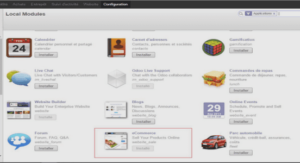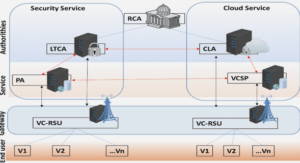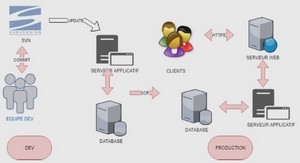Nowadays Wireless sensor Networks technology has become tremendously vital in a diversity of aspects, since, it has become intensively necessary in many different domains where the use of this cutting edge technology turned out to become not only an option but crusial, whether in ordinary utilization, in health environ ment or in Military use. Indeed, there is numerous diverse sorts of Wireless sensor Technology, that differs regarding the domain of use, such as Zigbee Wireless Sensor Networks who are better for energy comsumption efficiency, or Wi-Fi Wireless Sensor Networks who offers higher data rates and enhanced performance, ail of them have its special domain of application.
Apart from this introductory chapter, this dissertation will contain three more chapters. Initially the literature review chapter which is going to underline and stress the diverse significant theoretical and background points that will be required to accomplish this M.Sc.A. final project, and which have been utilized in this research project, this chapter will give a theoretical point of view of the need behind the Wireless Sensor Network as weil as some theory behind diverse WSN technologies, especially the routing protocols.
Afte rwa rd , in the findings and Discussion chapter the main relative findings of the research will be discussed; then , from that discussion some conclusion might be made such as whether or not the number of nodes utilised in the WSN affects the Network performance, And what routing protocol is performing better and so on and so forth, also, this chapter will enclose some figures and tables which will be presented to show the result of the testing and simlation steps. And finally, in the conclusion chapter, a summarise of what was performed throughout this report will be presented; then, some recommendations which might improve the performance of the WSN, will be given, so that, it probably will help to achieve further research in the domain of WSN.
WSN Applications
WSN have different kind of applications in several domains su ch are health, Military, national security and the Internet of things .
Health
Health Problems related to modern life style have risen during the last decades and the need to get a technological solution has also increased. One of these solutions is WSN [1]. A research on heart diseases made at Framingham institute came to the conclusion that many cardiovascular diseases can be avoided due to physical activities [1]. And a new publication proved that around 10 percent of the total number of deaths in 2008 are caused by lack of activity [1]. Recent research acclaims 150 minutes of sport every week for adults. But about 33 % of adults do not practice enough training and sport, thus these people are significantly more vulnerable to diabetes and cardiovascular diseases [1]. Eating habits have altered throughout the last fi ft Y years. Aiso the popularity of fast and processed foods increased steadily, those kinds of foods contains more amount of fat salt and sugar. Meals based on meat has become very common, and the consumption of vegtables and fruits declined, thus, the amount of calories rose triggering increase obesity and diseases related to it.
Ali these health problems mentioned above, have to be tackled by research and technologies, where cams the need to WSN in this filed. For instance wireless sensors can be connected with the patient’s organs and send information to the doctors in real time.
National Security
Nowadays national security risk of non-classical crimes, is considered as a steady issue for both citizens and governments, These dangers vary from chemical and biological to even nuclear and radiological. Unceasing observing and extra caution is consequently needed to thwart these kind of threats. Even though detection methods which relies on laboratory analysis shows outstanding sensitivity and results, these laboratory are usually far away from the menace zone, therefore, this many cause many issues such as substantial delays and struggle in terms of information gathering. Hence the fundamental need of wireless sensors deployed in the threat zone and able to gather information promptly and send it in real time to the laboratory or the research institutions.
ln this case WSN are required to identify risks in different places and conditions, su ch as on land or in air and so on.
The Internet of Things
The Internet of things has bounded our lives in a variety of ways. Thanks to ubiquitous internet connectivity, and sophistication in Information technologies, loT has become a de facto need for many individuals, institutions and companies. This fact will change drastically the life style of many human being in many aspects like distraction, employment and education. WSNs contribute significantly in interacting with the outside world, Like many other technologies loT is not an exception in the sense that its success depends on binging perceptible advances and enhancements to human being. It is expected that WSN are going to be vital in delivering data flows, that loTs projects will be developed.
Rooting Protocols
DSR
ln 1994 Johnson introduced the DSR, DSR stands for Dynamic source routing, and it uses what is called « route discovery » and « route maintenance » technics. ln DSR every node preserves a path cache with new information that changes constantly when node acquires new paths. Anode willing to direct a packet will primarily examine its route cache to find out if it previously had a route to the end point. And this is alike the AODV protocol. And in the case where no available route in the cache, the sender starts a path discovery procedure through a path request packet, which encloses the destination’s address, the source’s address and a sole application ID. When the request spreads across the network, every node enclosures its particular address inside the application packet prior re-spreading it. As a result, a request packet registers a path containing the entire nodes it has cali on. And once anode gets a request packet and discovers its sole address logged in the packet, it throw-outs this packet and stop spreading it more. A node preserves a cache of freshly forwarded application packets; saving their sender request unique IDs and addresses, and rejects every identical request packets. When a request packet reaches its endpoint, it will save the whole route from the source to the endpoint. ln what so-called « symmetric network », the target node is able to unicast an answer packet, covering the gathered path information, back to the source node using the rigorous identical route as used by the request packet. And in the case of what is known as « asymmetric network, the destination is able to originate a path discovery method from the source to the endpoint.
As soon as the reply packet reaches the source, the source node will be able to save the novel path inside its cache and begin conveying packets to the endpoint. The DSR routing protocol, is also alike the AODV in another point, they both retains a path conservation method founded on error messages, that are produced when the link layer senses a communication breakdown because of an interrupted link. Each packet in DSR conveys path information, unlike AODV. This advantage of DSR over AODV permits to in-between nodes (Between source and destination) to insert novel paths preemptively to their personal caches.
AODV
Ad hoc on- Demand Distance Vector (AOVC) Protocol was invinted by Pekins And Royer in 1999. Nodes do not preserve routing details and do not contribute in cyclic routing table updates.
AODV utilizes what so called broadcast route finding method. When the source lacks routing details in its table, the AODV’s route finding procedure, is started when a source node wants to send data to alternative node. ln order to do this, the source node transmits a route request (RREQ) packet to other nodes that are near it, these nodes encloses the addresses of the endpoint and the source, the hop total value, a transmission ID and dual sequence numbers. The transmission ID will be increased by one when the source node discharges a novel RREQ packet that is joined to the address of the source node in order to solely identify a route request. As soon as anode obtains a route request packet, anode, which owns an existing path to the endpoint node, replies by transferring a route reply (RREP) message straight to the node that was behind the launching of the route request (RREQ). Then, the route request is resent by the node to its in-between neighbors. Thus an identical route request (RREQ) is rejected.
Every node in the topology preserves its private sequence number. And If a source node delivering a route request packet it already have its specifie sequence number. Therefore, In-between nodes do not respond to a RREQ unless the sequence number of their path to the endpoint node is (>=) greater than or equal to the endpoint order number stated in the route request packet. Whenever a route request is resent, the in-between node saves the neighbor’s node location, from which the route request was obtained, thus creating an opposite route from the source node to the end point node.
Chapter 1 : Introduction |





